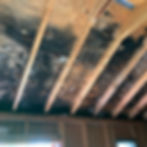

Georgia Attic Mold: Attic Mold Prevention in Georgia & Post-Storm Remediation
Sep 9
4 min read
0
1
0

When storms, roof leaks, or high humidity introduce moisture into attic spaces, mold can appear fast — sometimes within 24–48 hours — and then spread into walls and living areas. For true attic mold prevention Georgia, homeowners must focus on moisture control, attic ventilation, and fast post-storm response to stop small problems from becoming expensive, unhealthy infestations. Georgia Department of Public Health
Why Attic Mold Prevention in Georgia Matters
Attics are a perfect storm for mold: warm, humid air from living spaces rises and meets cooler roof sheathing, condensation forms, and insulation or wood becomes a food source for mold. Controlling moisture is the single most important step in preventing attic mold in Georgia’s climate. US EPA
How Attic Mold Develops After Storms or Leaks
Smoke, water, and storm events introduce moisture in a few common ways:
Damaged shingles, flashing, or vents that let rain into the roof deck.
Clogged or damaged gutters that cause water backflow.
Plumbing or HVAC leaks that saturate attic insulation.
High indoor humidity and poor attic ventilation allow condensation to form.
If trapped moisture is not dried quickly, mold spores will colonize porous materials (insulation, wood, old cellulose) and spread — sometimes invisibly behind sheathing and in cavities. FEMA and EPA both emphasize drying and moisture control as the first line of defense after water exposure. FEMAUS EPA
Immediate Steps Homeowners Should Take (First 24–48 Hours)
Stay safe first. If there’s structural damage, roof instability, or electrical hazards, evacuate and call professionals.
Stop additional water entry. If the roof is damaged, cover exposed areas temporarily (tarps) and clear clogged gutters if safe to do so.
Document the damage. Photos and videos help with insurance claims and the scope of work.
Begin drying. If safe and possible, increase air flow with fans, run dehumidifiers, and open attic access to ventilate. For large wet areas, professional drying equipment is recommended — mold can take hold within 24–48 hours. US EPACDC
Steps Professionals Take During Post-Storm Attic Mold Remediation
When mold growth is visible or suspected in an attic, experienced remediation pros will:
Conduct a thorough inspection and moisture mapping (thermography & moisture meters).
Contain the work area to prevent spore spread into living areas (negative pressure, barriers).
Remove and dispose of saturated/porous materials (affected insulation, rotted drywall, etc.).
Mechanically clean and HEPA-vacuum structural surfaces that can be salvaged.
Dry the structure completely with industrial dehumidifiers and air movers.
Apply approved antimicrobial/antimold treatments where appropriate.
Repair the moisture source (roof, flashing, gutters, plumbing) and recommend ventilation/dehumidification solutions to prevent recurrence. US EPAClean Way Restore
Long-Term Prevention: Stop Attic Mold Before It Starts
Fix roof leaks and flashing immediately. Even small, chronic leaks create mold-friendly microclimates.
Improve attic ventilation. Ridge vents, soffit vents, and continuous airflow reduce condensation.
Insulate & air-seal attic penetrations. Prevent warm interior air from rising into the attic where it can condense.
Use a dehumidifier in humid climates or poorly ventilated attics. Maintain indoor RH below ~50% when possible.
Regular inspections after storms. Check attics, gutters, and rooflines after heavy rain or wind events.
Controlling moisture is the core strategy for attic mold prevention Georgia — EPA guidance and multiple public health resources all prioritize moisture control first. US EPACDC
FAQ — Attic Mold Prevention Georgia
Q: How quickly can mold grow in a damp attic? A: Mold can begin growing within 24–48 hours on a moist surface. Quick drying is essential. US EPA
Q: Can I clean attic mold myself? A: Small, isolated areas (under ~10 sq ft) can sometimes be handled by homeowners following EPA/CDC guidance. Larger infestations, porous material contamination, or when HVAC/insulation is involved requires professionals. US EPACDC
Q: Will my homeowner’s insurance cover attic mold remediation? A: Coverage depends on cause. If mold results from a covered peril (sudden roof damage from a storm), remediation is often covered. If due to long-term neglect or lack of maintenance, claims may be denied. Document damage and contact your insurer promptly. (Clean Way can assist with insurance coordination.)
Q: What signs indicate hidden attic mold? A: Musty odors, discoloration on ceilings, high indoor humidity, and recurring allergy symptoms after being in the home. If you suspect hidden mold, get a professional inspection. Georgia Department of Public Health
Links that you should check out:
U.S. Environmental Protection Agency — Mold cleanup in your home. https://www.epa.gov/mold/mold-cleanup-your-home. US EPA
Centers for Disease Control and Prevention — Mold cleanup guidance & tips. https://www.cdc.gov/mold. CDC
Georgia Department of Public Health — Indoor Air Quality / Mold information (brochure). https://dph.georgia.gov/environmental-health/indoor-air-quality. Georgia Department of Public Health
FEMA — Mold: Problems and Solutions (post-disaster guidance). https://www.fema.gov/press-release/20250121/fact-sheet-mold-problems-and-solutions. FEMA
Why Choose Clean Way Restoration (Georgia) for Attic Mold & Post-Storm Remediation
At Clean Way Restoration, we’re a family-owned, locally based restoration company serving Georgia since 1987. We provide end-to-end remediation and construction services — from emergency drying and mold remediation to reconstruction and repair — and we work directly with local and national insurers to streamline your claim. Our team uses moisture mapping, containment, HEPA filtration, and proven drying protocols to stop mold and prevent recurrence.
Locally owned & family-run since 1987.
Turn-key water, mold, fire & storm restoration.
24/7 emergency response and insurance coordination.
Protect Your Home from Attic Mold — Act Fast After Storms
If your Georgia property experienced roof damage, attic leaks, or prolonged humidity after a storm, don’t wait. Rapid action — documenting damage, stopping new water entry, and starting professional drying — is the best way to prevent attic mold and avoid costly repairs later. Call Clean Way Restoration for a prompt assessment and full remediation plan










